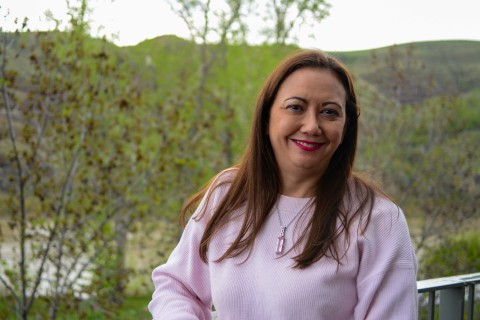Demand-side management can be a highly useful tool in reducing emissions, driving down energy costs, and safeguarding the reliability of electricity grids. It has broad relevance for utilities across Canada. Summarized below is some of our recent thinking about how DSM, applied with an equity lens, can help reach customers from diverse backgrounds.
What is demand-side management?
Demand-side management (DSM) is the name for a variety of strategies to manage how and when electricity is used, saving money for utilities and their customers. DSM programs encourage customers to reduce total energy use or to shift the time of day they use energy. These programs work because they provide a direct financial benefit to the customer for upgrading equipment or changing behavior. Paid as a rate or an incentive, these programs save building occupants money. When delivered across a broad customer base, they can greatly improve the performance of a regional electricity grid.
DSM programs are led by or invested in by utilities, sometimes administered by third parties, and often delivered as rebate programs. In Canada, governments provide the overall direction for utility DSM through policy and direction to the provincial utility regulator.
What are examples of demand-side management in Canada?
Some well-known DSM programs include rebates on more efficient heating, ventilation, air conditioning equipment or insulation; incentives for on-site electricity generation, such as payments to building owners or occupants to install solar panels, and programs, known as demand response, that allow the utility to ask participating customers to reduce specific uses for short periods of time—for example, air conditioning or heating water.
Here is a snapshot of some DSM strategies currently in use in Canada (this is not intended to be an exhaustive list).
Energy Efficiency
Energy Efficiency is sometimes called the “first fuel” because it is the most cost-effective and readily available resource for meeting growing energy demand and reducing energy-related costs and emissions.
The Ontario Independent Electricity System Operator (IESO) reports that its energy efficiency programs have lowered provincial energy demand by 15 per cent compared to what it otherwise would be (meaning, 15% of new load is served through the reallocation of energy otherwise wasted by inefficient equipment).
In British Columbia, FortisBC is investing close to $700 million on demand-side management programs from 2024 to 2027 to help their customers reduce their energy use over the course of the next four years.
An Alberta-based study estimated that a combined annual investment of $150M (CAD) in energy efficiency programs across all Alberta utilities would deliver $1 billion (CAD) in gross savings for every year of energy efficiency programming. This level of investment would also produce 4.4Mt of GHG emission reductions. The International Energy Agency (IEA) suggests that between now and 2040, energy efficiency measures alone could provide more than 40% of the emissions reductions that the world needs to meet net-zero.
In addition to the residential, commercial, institutional and industrial efficiency programs available in many jurisdictions across Canada, utilities often deliver subsidized services targeting low-income communities. Individuals who live in low-income households are more likely to experience energy poverty (defined as spending 6% or more of income on energy needs), which can be exacerbated due to home energy inefficiencies.
Examples of utility programs for customers with qualifying income levels can be found across Canada, and may include free home energy assessments and free or subsidized upgrades, such as insulation, draft proofing and a smart thermostat.
Demand response
As defined by the IEA, “demand response refers to balancing the demand on power grids by encouraging customers to shift electricity demand to times when electricity is more plentiful or other demand is lower, typically through prices or monetary incentives.”
In Ontario, as one example, the Independent Electricity System Operator (IESO) offers financial incentives to consumers for reducing energy usage during peak hours, available to customers who have a smart thermostat connected to an air conditioning unit or heat pump. Customers are free to opt out if they don't want to participate during a particular peak demand event.
Why does equity matter for DSM?
While utility DSM programs provide utilities with a cost-effective source of saved energy and capacity that can be used for higher value purposes on the system, it also saves participating customers money. Energy efficiency retrofits can bring additional value to homes and businesses, making interior environments more comfortable and improving indoor air quality. Retrofits can also provide better protection against extreme weather events. Taking action on equity has been shown to improve energy access and affordability, economic participation and community ownership, and health and environmental impacts. Utilities benefit from increased participation when programs are designed and implemented with diverse needs in mind.
Where utilities can start
The Pembina Institute works with utilities across Canada. Drawing on an analysis of successful DSM programs in North America, and our experience with individual utilities, we have created a program design check list for utilities interested in ensuring their programs will be accessible to the full range of customers.
- Educate staff on diversity, equity, inclusion and belonging. Create the opportunity for your team to better understand the customer base the program is intended to serve.
- Dig into the data. Analyze anonymized program participation data against neighbourhood or community level information to understand participation by factors such as income, household composition, gender, race and language.
- Engage disproportionately impacted communities. Tailor outreach and engagement to the needs of the target group. Simple actions, like meeting with community members in a location they typically gather, matter.
- Develop multilingual and accessible communication. Use plain language, avoid technical jargon and define terms. Consider providing translations of key material and information into the language used in the community.
- Remove entry barriers. Consider conducting needs assessments through community engagement to identify community leaders and surface accommodations required for different individuals in a community.
- Engage in community spaces. Tailor outreach and engagement to the needs of the target group. Simple actions, like meeting with community members in a location they typically gather, matter.
- Improve affordability for end-users. Map a customer’s journey through your program to identify where participants experience up-front costs and financial benefits, and explore program design elements that align those.
- Prioritize equity in network building. Incorporate local businesses into programs, such as recruiting community-based contractors in a home retrofit program.
- Support capacity building and access to opportunities. Take a holistic approach where possible. By collaborating with other programs, such as the local municipality, or energy poverty and housing stakeholders, you can often improve access to your program while building capacity for the community at large.
Expanding DSM solutions to address energy poverty effectively
Utility-led DSM programs almost always include income-qualified initiatives aimed at addressing energy poverty. Income-qualified programs are common among Canadian utilities, yet their size and scope vary significantly, leaving gaps in effectively meeting participants’ diverse needs. One-size-fits-all approaches, such as distributing energy efficiency kits or providing one-time bill relief, fail to address the systemic challenges of energy poverty. To drive meaningful change, utilities must expand their program investments. It is useful to look to successful models in other jurisdictions, such as the Southern Maryland Electricity Cooperative, Georgia Power and the Sacramento Municipal Utility District, which demonstrate the potential of robust, tailored programming.
Policymakers and regulators need to adapt the metrics they have traditionally used to assess the costs and benefits of these programs. Standard evaluation frameworks often constrain utilities, limiting their ability to implement comprehensive solutions for income-qualified customers. By providing greater flexibility and reducing investment restrictions, decision makers can empower utilities to design and execute innovative programs that address energy poverty at its roots, fostering long-term affordability and energy equity.
Reap the rewards
The success of DSM programs ultimately depends on customer participation—homeowners, building owners, electric vehicle owners, businesses and industrial consumers—who adopt the necessary technologies and behaviors. Taking steps to design and measure the effectiveness of programs with equity in mind can both increase program participation and build powerful relationships between utilities and the communities they serve.
While utilities determine DSM programming investments to reduce costs to their customer base as well as to the electricity system as a whole, provincial government create the policy frameworks that determine the criteria for success and the level of investment that utilities can provide. Beyond good program design, governments need to deliver policy frameworks that enable and require utilities to invest in and administer DSM initiatives that benefit all customers.













